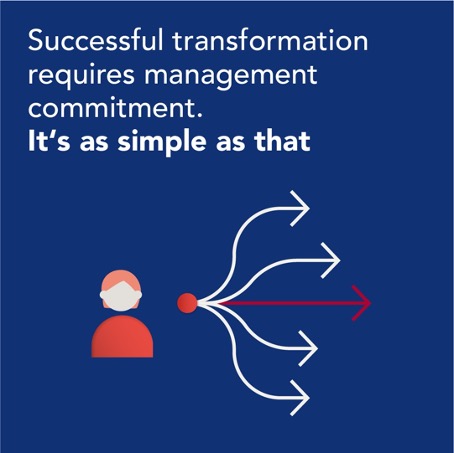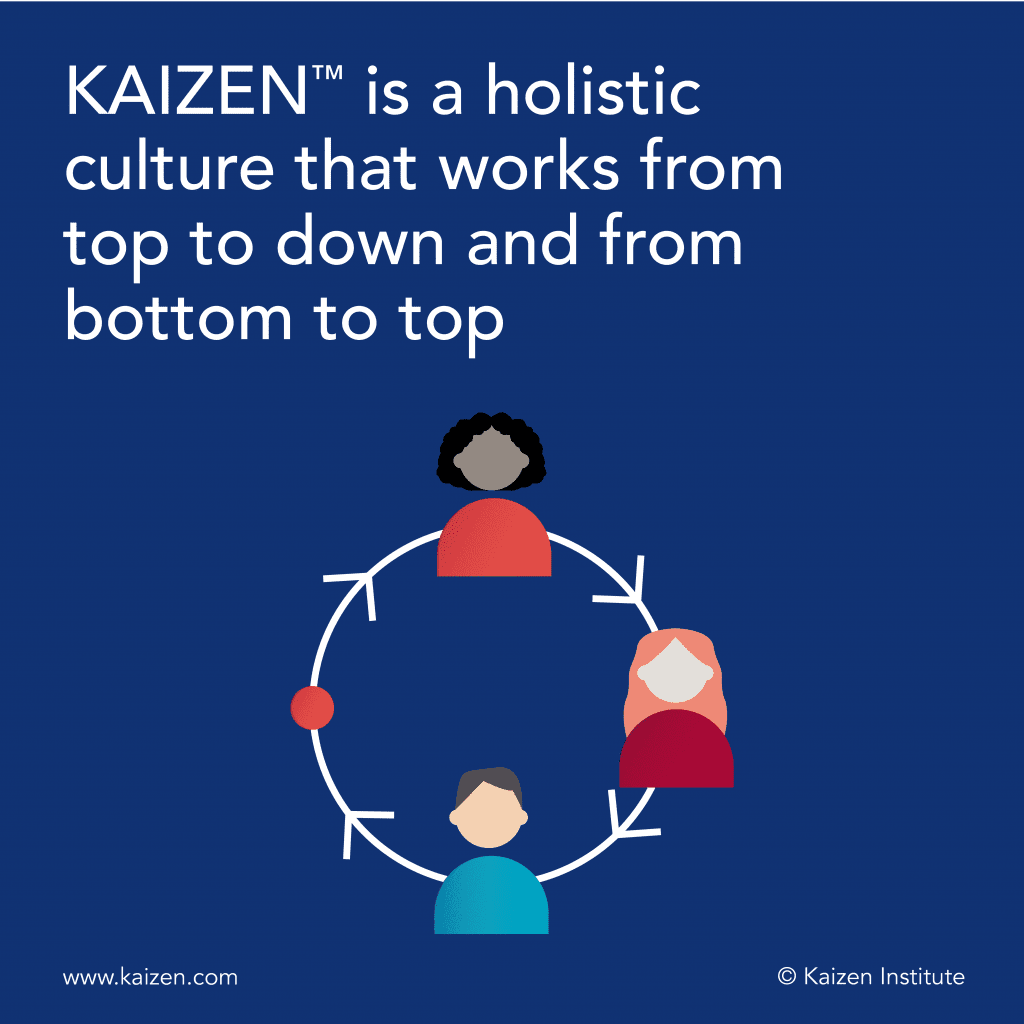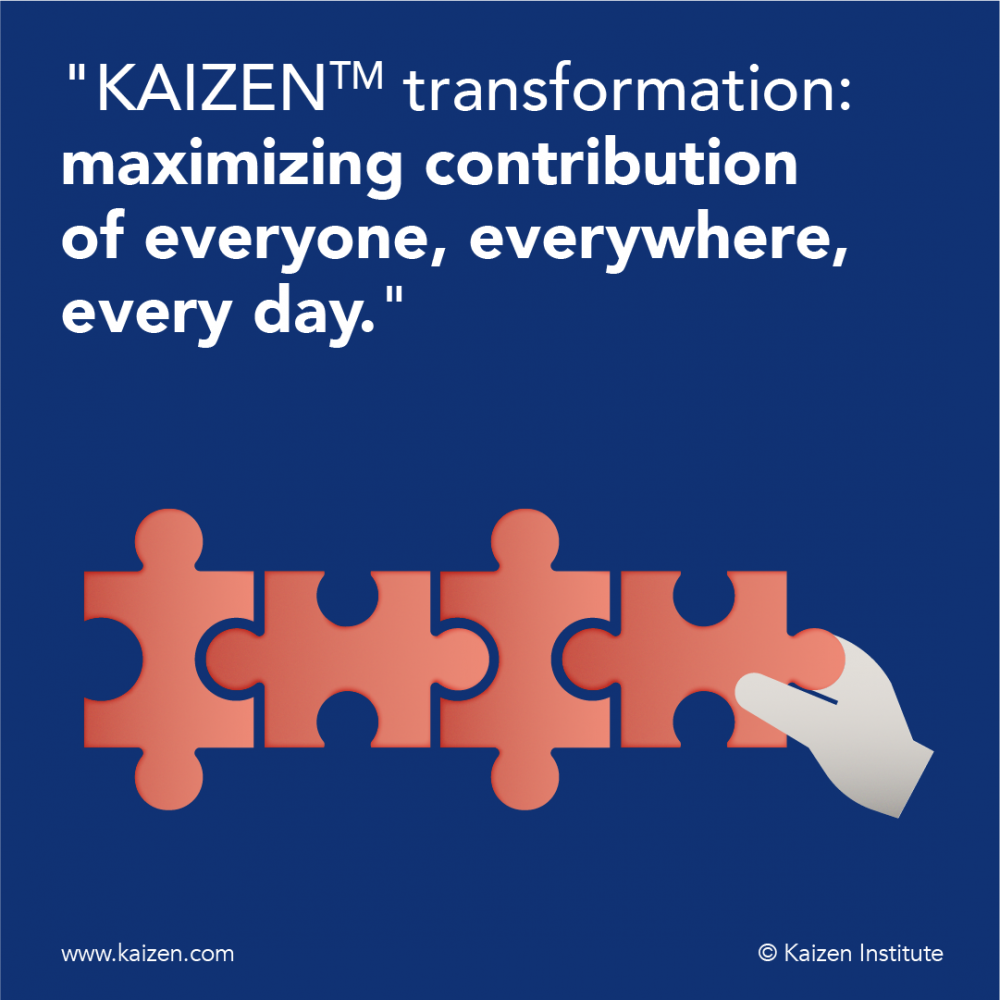
Article
The KAIZEN™ Way
to re-shaping the economy
by Kimmo Järvinen, Director, Operational Excellence, Kaizen Institute, Ltd.
In the last few years, disruptive events (such as the COVID-19 pandemic) forced companies to change and adapt, many leaders see a huge opportunity to re-shape the way we run businesses: Hybrid work, sustainable business models, circular economy – many topics that previously filled boardroom discussions with doubt now seem within reach. Let me give you a KAIZEN™ perspective on re-shaping the economy.
Improving leadership
Mixed hopes for leaders
Let me start with a view from the top: What’s changing for CEOs and managers? Where is the opportunity for them to embark on a new future that overcomes some of their past challenges?
Large-scale quantitative studies, such as Microsoft’s annual Work Trend Index, provide a starting point. Released in March 2021, the study confirms that overall, leaders got through the pandemic positively. For example, 61 percent say they have been doing well in a mainly home office environment. Yet, there is also a flip side to this positive scenario: The report reveals that 41 percent of employees considered leaving their employer. The pandemic has brought this figure to an all-time high, as many individuals are looking for their personal “why” and are willing to question fundamental things.
Start by looking at the flow of work
For many companies, this means initiating comprehensive cultural transformation in order to remain attractive employers. Masaaki Imai, founder of Kaizen Institute, specifically looks at this in his new book, Strategic KAIZEN™. While employees and customers alike are increasingly criticizing the fact that for many business leaders, the financial yardstick still applies first, the potential lies in customer-value-creating business processes, such as operations. Gemba (the place of value-creation) is where the work is getting done. That’s where much of the time and resources are wasted and inefficiencies are commonplace – and that’s where leadership needs to happen.
KAIZEN™ urges executives to abandon the traditional focus on financials and volumes only and replace it with a concept of flow: a smooth, continuous, and expeditious flow of work, synchronized throughout the entire organization. Creating the conditions for flow to happen – this is the role of business leaders.
Commitment counts
As a key lesson from Masaaki Imai, and that is backed by my experience in business, I would like to make the point that, from a leadership perspective, there are only three important things in making a business future-ready:
- Management Commitment
- Management Commitment
- Management Commitment
It’s almost as simple as that. KAIZEN™ is a very practical philosophy. We do not need loads of colourful slides to explain our approach to transformation: It is happening in process, we pay attention to where value is created, and try to optimize this step by step. This requires top management to be fully committed – and to be present at the places of action.

Against chaos in crisis
This mental presence helps us to avoid making things more complicated than they need to be. That’s particularly true in times of crisis and disruption. We can see this in many digitalization and automatization efforts of traditional companies: Some businesses tend to over-process their efforts to make innovation happen. We are pro innovation, but against the chaos that is sometimes generated around new things. Let’s take the waste out of the process, and in that way ensure a smooth process that is fast and flexible enough to embrace rapidly changing markets – to enable for digitalization and automatization.
Doing more by less: A sustainable approach
This mindset is also helpful in addressing the urgent topics that the COVID-19 pandemic made even more visible for all of us: the growing demands from society on businesses to tackle social and environmental issues and the according request for more sustainable business models in the future. The principle of doing more by less can help to use raw materials in more efficient ways as well as innovating and developing more environmentally friendly processes and technologies.
One key question remains: How can businesses stay in flow with the environment? In order to find an appropriate answer, it is now the wrong time for leaders to be relaxed. There are many companies who managed to grow during the pandemic. These are the ones we need to look at, as they will most likely continue to thrive in the future. The gap between good and bad players in the economy may have widened – now is the right time to accelerate development. The leaders that train their muscles every day, will be ready to run any time!
This is why looking beyond the tools and implementing KAIZEN™ as a culture is equally important in shaping the post-pandemic economy.
A culture of common sense
While I already made the point that it is now more important than ever for leaders to be present, it is apparent that the COVID crisis has also transformed the way we work – and, therefore, our work culture overall. During these times, there was no rule book – many companies improvised in keeping their operations up and running in the most efficient and effective way. Now, after some time in mainly remote environments, we have realized that in many cases we will not return to the same culture that existed pre-pandemic.
Well-prepared for dealing with paradigm shifts
This is at least, what we’ve been reading in many studies and articles. Is it really the case, though? We observe that – while the pandemic was truly unfortunate – a range of organizations seemed more prepared than others, able to react quickly on a Continuous Improvement path. Let me raise the hypothesis that organizations that fully embrace KAIZEN™ Principles were generally more prepared to cope with such a significant incision in our daily work.
We hear this from many customers and partners – ranging from production companies to kindergartens whom we advised on how to react to deviations and working habits. Many of our customers basically just copied their physical visual management boards on virtual whiteboards – and were ready to continue in a remote work environment.
Ensuring the development of everyone
So, what’s the magic behind the KAIZEN™ culture that appears so robust in times of crisis? In the Western context, Harvard researchers Robert Kegan and Lisa Lahey in their book An Everyone Culture made a point for so-called Deliberately Developmental Organizations (DDOs) in which growth and development are not bought in selectively for individuals or teams from the outside, but the ongoing development of people becomes firmly interwoven into everyday work. Such organizations provide evidence that a tension between “business excellence” and personal fulfilment at work doesn’t need to exist. They show that individuals and organizations can flourish in learning and development mode – as long as development, and, with this, various ways of Continuous Improvement, are made key principles of organizational culture.
Belief in the system beyond implementing tools
While such DDOs are often taken as role models in New Work discussions, I would like to create a hypothesis that KAIZEN™ is a cultural system that has always included developmental principles: KAIZEN™ means ‘everyone, everywhere and every day improvements.’ This type of KAIZEN™ requires a belief in the system and goes far beyond the world of implementing tools: It is deeply inherent in all daily processes and goes far beyond the application of individual tools.
KAIZEN™ in our definition is a holistic culture that works from top to down and from bottom to top. This way, KAIZEN™ culture makes teams more autonomous in a way that they will be able to control their own way of working and monitor themselves. Let’s take the example of capabilities: Once a team standard is defined, then deviations can be noticed and countermeasures implemented by team members themselves, and better standards can be created – autonomous development is accelerated.

A system to build shared common sense
This bears, particularly in times of pandemic, great business opportunities for companies that are able to manage, sustain and improve over longer periods. This includes Daily KAIZEN™ practices – realizing a mission for the Gemba team and then starting to understand waste, i.e. finding the easiest way to reach the mission. That’s where value is created – and based on reliable standards, teams can act highly autonomously.
Seen this way, KAIZEN™ culture is not something extraordinary – but rather a system that builds shared common sense. Everyone is involved in implementing improvements in their own work. This is quite the opposite from tool implementation – it’s applying the entire system in daily work that leads to growth and improvement over time.
Then the next question could be the following: why KAIZEN™ is a great philosophy to increase trust and transparency across post-pandemic organizations?
Trust and transparency
While I already raised how important it is for leaders to be present and to create a culture of common sense, I think there is a third aspect that is important for organizations in dealing with the effects of the pandemic: the far-reaching changes that companies have been experiencing require a willingness to take risks, initiative and proactivity from every single member of the organization. This is hardly possible in organizations that are managed via control with limited people involvement for Continuous Improvement.
Moving beyond bureaucracy
Despite all predictions to the contrary, hardly any area of business has grown as strongly in recent decades as administration. The pandemic hasn’t changed this overnight – and, in parts of the economy, even increased the challenge.
Structures have their good reasons: They aim to ensure reliable, repeatable quality and efficiency through standardized processes. The optimization of corporate structures has made a significant contribution to increased prosperity in recent decades.
At the same time, development of non-value-adding bureaucracy is increasingly coming to an end. With the world changing at an accelerated speed, it is necessary for organizations to change as well in order to keep pace. Companies need to go beyond rewarding and autonomous diligence, expertise, and obedience. These skills are essential in structures and standardized ways of working, but they do not stand for agility, innovation, and growth. For this, it requires an organization that breaks away from the model of controlling toward an organization that puts people at the center, that ensures and elevates the participation and impact of the individual.
Creating human organizations
Business thinkers Gary Hamel and Michele Zanini, for example, refer to this form of organization as “humanocracy” – an organization that brings out the best that people can give by maximizing their contribution: Every employee should gain the opportunity to participate in solving problems, especially customer problems. In parallel, the “humanocratic” organization is characterized by small, powerful, self-controlling and self-organizing units.
This harmonizes well with Masaaki Imai’s definition of KAIZEN™: Improving with Everyone, Everywhere, Every Day – which is also one definition of a humanocratic organization.
Transparent communication is key
In KAIZEN™, we add an additional point by acknowledging that communication is very important in fostering creativity and innovation. It is, on the one hand, a leadership task to bring out tough and soft messages – both are necessary. And on the other hand, communication is also a principle that is built into the system: It is all about creating full transparency, nothing is hidden. It starts with the point that all information is visible to all employees – whether it is on whiteboards on site or on virtual whiteboards such as MS Teams. In a KAIZEN™ transformation, all layers of the organization are involved and encouraged to improve. That’s what we call maximizing contribution of everyone, everywhere, every day.

Trust follows transparency – and reflection
This type of transparency also creates trust – within the teams in the form of psychological safety, and with customers to become trusted partners in the long-term. It’s our aspect of humanity in a sense that it is also linked to an ongoing self-reflection, and, subsequently, with a development to put more emphasis on the individual needs of all employees.
In KAIZEN™, we are reflecting how we are doing, all the time: It starts with looking at where we stand today. Tomorrow we will already have improved a little bit – and this can be tough, to identify what could be done in a better way every day! The key questions are: What was good? What was not so good? How can we improve? This way, we can come to lessons learned. We can celebrate – and always have a meaningful discussion on what we can do differently with the next delivery, in the next project, in the next strategy round etc. – again, everyone, everywhere, every day at each layer of organization.
Never blaming people
This reflection, by the way, is not limited to leaders and managers: All KAIZEN™ teams must reflect about themselves. There is no individual finger-pointing – and in case processes are broken, there is one rule: to never blame people! Our goal is to create a high level of trust and engagement in the entire organization: “Why hiring hands only as you get the brains for free at the same time?”, might be a relevant question. The way we address this in KAIZEN™ is by humanizing the organization top down and bottom up. Let’s get started today!